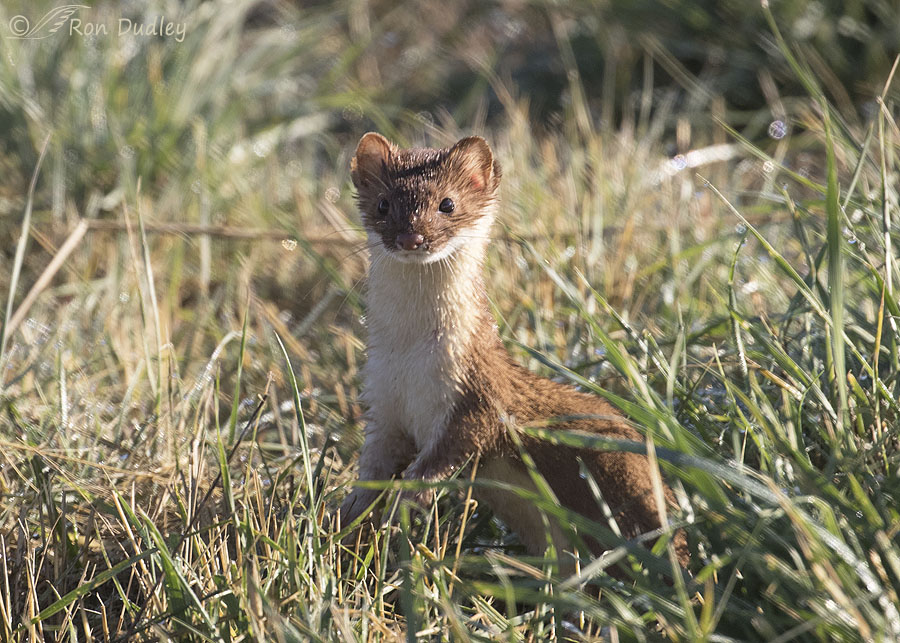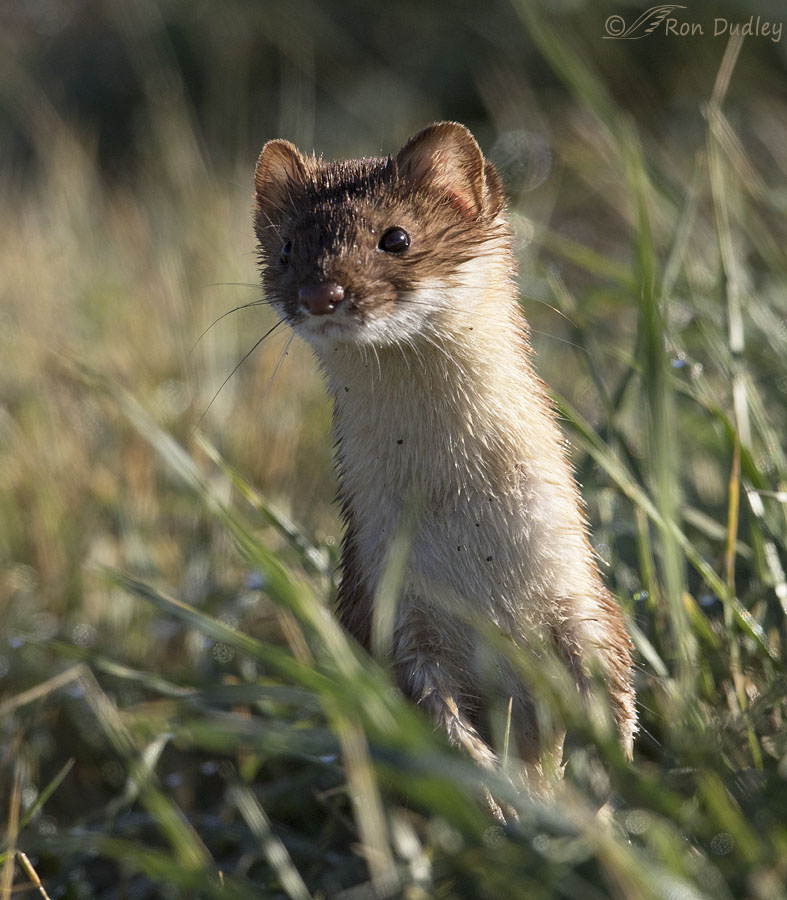My extended weasel drought came to an end yesterday morning at Farmington Bay WMA. The photos aren’t stellar but I was sure happy to get this little guy in my viewfinder.

As usual for these hyperactive and very small mustelids ‘he’ was a damned tough subject. I spotted him crossing the road in front of me while I was driving south. When I found him again he was on the east (left) side of the road and close to Unit 1 so I was strongly tempted to drive straight into the water to get decent light on him! But in the end I pulled up short of the water and settled for strong sidelight. I’ve been stuck at Farmington before and it isn’t any fun (thanks again to Joe Ford for pulling me out).
In the long grass he had to hop from place to place to get anywhere so he was impossible to follow with my lens while he was moving and always partially hidden when he wasn’t.
When I first pulled up on him I was using my 500mm lens and I was too close for that much focal length so I switched to my much smaller zoom lens. This was the only relatively sharp shot I got with the zoom where I had any light in the eye.

This is one of the first photos I took with my big lens. It’s a little tight but it gives us an intimate look at him. His front legs are wet, probably from dew, and I’m wondering if those few white? hairs we see on his forehead might be the very beginning of their seasonal color change to white. Those white hairs almost make both images appear over sharpened (crinkly) but I don’t believe they are.
This species turns white for the winter (except for the tip of the tail which is always black) and I’m slightly surprised he’s not at least partially piebald by now. Weasel color change is triggered by length of day rather than temperature so even with the warm weather pattern we’re in I wondered just a couple of days ago if they might be beginning to turn color by now.
Apparently not, at least not to any obvious degree.
Ron


Thanks for sharing these Very charming pictures of this guy/gal?
What an alert looking little fellow. Reminds me when I was on a lunch break during a hike and one of these guys popped up between the boulders. I threw him some nuts and was surprised he didn’t take them. Until I got home and was chagrined to read that they are obligate carnivores.
Yup, they sure are, Lyle. And if I remember correctly they won’t take carrion either.
How could something so cute be so mean?
My husband spotted a white weasel cross our back yard, weaving its way through the rocks. He got some photos.
Thanks for the photos and, as always, the education, Ron
Thanks, Alice. Did your husband spot the white weasel recently?
When we had chickens, we didn’t think they were cute AT ALL!!!!
Cute but not cuddly!!! I find the seasonal color changes totally amazing…(my own hair is completely white, possibly due to winter coming…do you think it’ll be dark brown again this spring???)
Patty, since color change is triggered by temp you should move to the south…
Awwww, so cute — and perhaps why I’ve often used the phrase, “You little weasel” as a term of endearment. Not that I’ve ever seen one in person, but your photos of them do elicit such a response! I will try to forget that you said they’re known to kill for the joy of it ….
I will try to forget that you said they’re known to kill for the joy of it ….
Yup, their cuteness belies their reputation, Chris. Thanks.
Good Morning Ron. Love the pictures of the Weasel. Seems like you are at the right place at the right time. I could sit all day and just watch all the wild life go by. Also like people watching!
“Seems like you are at the right place at the right time”
Trudy, if you’re ‘out there’ often enough and long enough it’s likely to eventually happen, even with weasels. Thanks.
Yet another fascinating post. I always enjoy it when you post photos of weasels, an animal I don’t expect to ever see. I’ve long known that plants respond to long/short day/night, and that short day and long night are not the same trigger, but had not realized that any animals were affected by day length. Always something new and interesting to learn.
Yup, I think it’s called photoperiodism in both plants and animals that are affected by it.
Could use these photos to illustrate the meaning of “alert” ! AND “bright-eyed”……..never having any experience with weasels, my immediate response was–awwww–for cute !
and then EC’s quip reminded me of the behavior to which weasels have lent their names– are they also vicious when cornered ?
They can be vicious at other times too, Kris. They have a reputation for killing apparently for the pure joy of it. Not sure how well deserved it is…
Ooooh.
Megathanks.
Not a beastie we have. Not a beastie I will ever see for myself. And a beauty.
EC, while I was composing this post I actually wondered if you have any members of the weasel family in Australia. I doubt it but I’ll have to do a little research to find out…
Nope, you don’t. But apparently ferrets are a popular pet in the land of Oz.
In some parts of Oz. They are banned in at least two states. And I have only ever known one person who kept them.
We have some introduced ferrets, but no weasels of our own. Unless you count politicians.
That’s an insult to the weasels.
That second shot! Love
Thanks, Arwen.
All around the merry go round the monkey chased the weasel ……..etc …….my mother did that with me back in the early 1940’s, but in all these years I have never seen a weasel except maybe in a zoo – cute picture of a cute guy Ron – thanks for sharing
Everett Sanborn, Prescott AZ
I used to see them fairly often on the MT farm, Everett. And I see them occasionally here in Utah but they’re sure difficult photo subjects!
He’s a handsome little guy. I love the way the light comes through his ears and also the glint of light off his fur. Enchanting — even if their adorableness is a ruse (the little bastards!).
Yup, they can be nasty little fellows in some situations, Marty but I love’em for it (but then I don’t keep chickens…)
Chickens? Nobody here but us chickens.
Nice! Seeing them much less getting them to stop long enough for a shot IS a challenge! I was surprised it wasn’t really turning white yet also – cute but also nasty little critters…..;) We have some “jack rabbits”??? not far from here that also turn white and with the chinooks they stick out like a sore thumb!
I was surprised it wasn’t really turning white yet also – cute but also nasty little critters…..;) We have some “jack rabbits”??? not far from here that also turn white and with the chinooks they stick out like a sore thumb! 
Judy, since the color change is triggered by length of daylight and your winter days have light for less time than ours do I wonder if your weasels turn white just a little earlier than ours do. I imagine so…
The white-tailed jack turns white in winter (except for the tips of its hairs) but the black-tailed jack doesn’t turn white.
Really great photos of this beautiful ‘wicked’ little creature! Love the close-up. Fearless! The eyes are so sharp…makes me wonder what was in it’s sight. I wonder with climate changes what effect that will have on these animals that turn white in the winter. They certainly will lose the edge of camouflage. Seeing a white ‘snowshoe rabbit’ without the accompanying snow once was startling. I was very lucky to follow a mink last winter down in the marshes for many weeks. He remains brown but has a white chin patch and just as ‘beautifully wicked’.
Fearless! The eyes are so sharp…makes me wonder what was in it’s sight. I wonder with climate changes what effect that will have on these animals that turn white in the winter. They certainly will lose the edge of camouflage. Seeing a white ‘snowshoe rabbit’ without the accompanying snow once was startling. I was very lucky to follow a mink last winter down in the marshes for many weeks. He remains brown but has a white chin patch and just as ‘beautifully wicked’.
Kathy, In winter these days I see white weasels with no snow around them more often than I do with snow. I wonder if evolution will begin to work in reverse…
Interestingly, southern weasels don’t turn white.
Ron – what neat shots! As always, thank you very much for your blog.
Thanks, Richard.